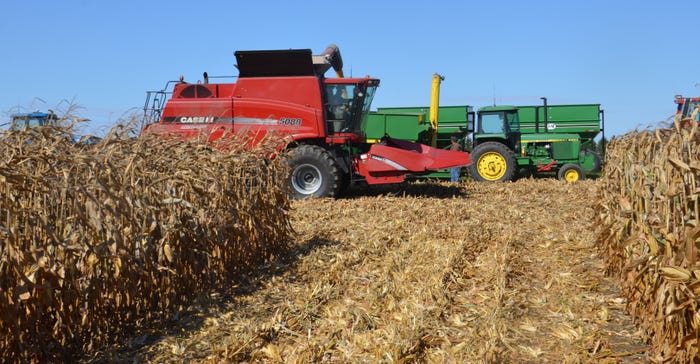
If you Google “corn harvest losses,” don’t expect to find much recent research on the topic. One of the more helpful bulletins is from Iowa State University, and it was last revised in 2008 and cites data from the 1970s. The University of Georgia also has a helpful bulletin on file, and although dated, it still explains how to check harvest losses in various crops.
Just because no one is paying much attention to harvest losses doesn’t mean they aren’t happening. “We had a lot of shelling at the head when we ran our first-planted corn, testing 17%,” says Pete Illingworth, crew leader for the Throckmorton-Purdue Agricultural Center near Romney, Ind. Losses were much less when they moved into corn testing 24% to 25%, he notes. Drying costs, however, naturally went up.
Illingworth knows the losses were minimal in the wetter corn because they were measured as part of the harvest date study conducted jointly by the ag center, Indiana Prairie Farmer and Bob Nielsen, Purdue University Extension corn specialist. The study consists of four replications of each of two hybrids, harvested at each of three harvest dates, to be spaced at least two weeks apart. Because the corn was planted June 1 due to the wet spring, the first harvest date was Oct. 23.
How to measure losses
The best way to measure losses is with a rectangular frame placed down over harvested corn rows. Here’s how such a frame was constructed for this study and how it was used to measure losses at the first harvest date, step by step. In this case, losses turned out to be minimal, averaging about one-third to one-half bushel per acre across the head, with perhaps a quarter to half bushel of additional loss per acre coming from the back of the machine. Exact losses will be presented when the study is complete.
1. Gather materials. The frame is made from 0.75-inch-diameter PVC pipe. Frames can also be made from wood or No. 9 wire. For 30-inch rows, both ISU and UGA suggest a frame with sides 48 inches long and 30 inches wide. The key is that inside diameter is 10 square feet. Then 20 kernels found inside represent 1 bushel per acre of loss.
2. Cut proper lengths. Use a hacksaw and remember — measure twice, cut once!
3. Use elbows to connect pipes. They should fit snugly. Only one joint slipped loose during the first day of use. Use glue to make connections permanent.
4. Lay frame over each row. In this case, it was a six-row combine. Pull back residue on the surface and look for corn kernels. Take measurements over each row and then average them together to get average loss across the head.
5. Check for loss behind the machine. You may find more loss where the most material discharges out of the machine. Add that to overall loss.
6. Check for full ears. A 0.75-pound ear in 1/100 acre represents 1-bushel-per-acre loss. In 30-inch rows, with a six-row machine, measure off 29 feet and look for whole ears across all six rows. If ears are smaller, add them together to meet the 0.75-pound equivalent. Add this loss to what you find within the frame.
7. Repeat the procedure several times. In this plot, each of four reps of each hybrid was checked for loss.
Unless you know how much corn you’re losing, you can’t appreciate how important it is to set combines and adjust corn head deck plate gaps correctly, experts say.
Check out the slideshow to see photos of the frame being build and used.
About the Author(s)
You May Also Like




